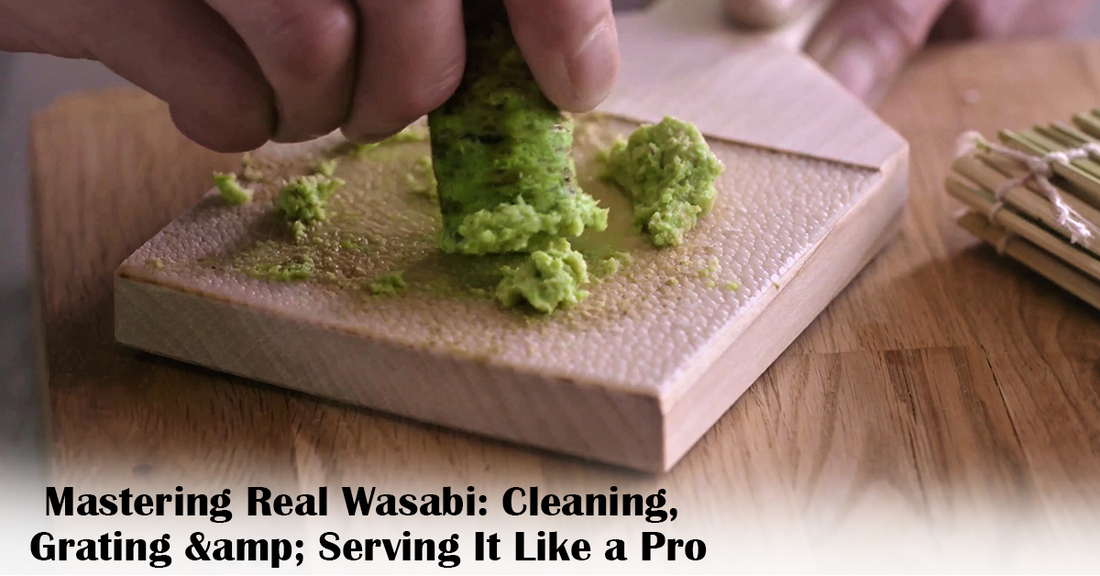Mastering Real Wasabi: Cleaning, Grating & Serving It Like a Pro


If you think the green paste served at most sushi restaurants is real wasabi, think again! Authentic wasabi, made from the Japanese horseradish plant, (Wasabia japonica) is a rare delicacy with a refined, fresh heat that fades quickly—unlike the fiery, lingering burn of fake wasabi made from western horseradish, mustard, and food coloring.
But preparing real wasabi isn’t as simple as chopping or blending it. To get the best flavor, you need to clean, grate, and serve it properly. Whether you're a wasabi enthusiast or trying it for the first time, this guide will show you the right techniques to enjoy fresh, flavorful Wasabia japonica at its peak.
What Makes Real Wasabi Special?
Unlike fake wasabi, which is mass-produced and overpowering, real wasabi has a smooth, slightly sweet heat that quickly dissipates, leaving behind a complex, earthy flavor. But there’s a reason authentic wasabi is harder to find:
l It grows in cool, shaded, mountain streams, requiring pristine water and specific conditions.
l It takes up to two years to cultivate.
l Because of its delicate nature, it must be grated fresh for optimal flavor.
If you're serious about exploring the world of real wasabi, it's essential to connect with an Authentic Wasabi Products Supplier to ensure you're getting the real deal. Now that you know why Wasabia japonica is so prized, let’s dive into the proper way to prepare and serve it!
Step 1: Cleaning the Wasabi Rhizome
Unlike other root vegetables, wasabi should never be peeled. The outer layer contains much of the plant’s signature aroma and flavor, so removing it would be a waste! Instead, follow these steps:
l Rinse the rhizome under cool water to remove any dirt.
l Use a vegetable brush or traditional Japanese tawashi brush to gently scrub the surface.
l Avoid using knives or peelers—this will strip away essential oils that give wasabi its unique heat.
This cleaning method ensures maximum flavor retention while preserving the natural, slightly fibrous texture of the rhizome.
Step 2: Grating Wasabi the Right Way
Grating is where the magic happens! Fresh wasabi does not release its full heat and aroma until it is finely grated. That’s why the right tool is essential.
Why Use an Oroshi or Shark Skin Grater?
Traditional oroshi graters—especially those made from shark skin (oroshigane)—are the best tools for creating the fine, creamy paste necessary for proper wasabi preparation. Unlike metal graters, which generate heat and damage the delicate compounds in wasabi, an oroshi grater preserves flavor and texture.
Here’s how to do it:
l Hold the wasabi rhizome at an angle and press it against the grater.
l Use a circular motion rather than up-and-down strokes—this breaks down the fibers gradually, releasing the signature heat and aroma.
l Let the grated wasabi sit for 5 minutes before serving. This allows the flavor to develop fully.
By using a traditional oroshi grater, you’ll enjoy wasabi as it’s meant to be—smooth, fragrant, and perfectly balanced.
Step 3: Serving Fresh Wasabi
Unlike pre-made wasabi paste, fresh wasabi has a short-lived flavor peak. That’s why timing matters when serving it!
l Use small amounts—Wasabi is best enjoyed fresh, so only grate what you need.
l Pair it with high-quality ingredients—The subtle flavors of real wasabi shine best with sushi, sashimi, or grilled meats.
l Serve within 15 minutes—After that, the heat and aroma begin to fade.
Pro Tip: Never mix wasabi directly into soy sauce. Instead, apply a small amount directly to your food to preserve its full flavor.
Storing Fresh Wasabi Rhizomes
Want to keep your wasabi fresh for as long as possible? Follow these storage tips:
Wrap the rhizome in a damp paper towel and place it in a sealed container.
Store it in the refrigerator, ideally in the crisper drawer.
Use within 2–3 weeks for optimal freshness.
By handling your wasabi with care, you’ll extend its shelf life and enjoy its unique flavor for longer. If you're looking to source high-quality rhizomes, check out trusted Wasabi Products suppliers that focus on freshness and authenticity.
Beyond Sushi: Creative Ways to Use Wasabi
While wasabi is best known as a sushi condiment, it’s a versatile ingredient that can elevate a variety of dishes. Try these ideas:
Wasabi Mashed Potatoes – Add grated wasabi to mashed potatoes for a spicy, flavorful twist.
Wasabi Butter – Mix fresh wasabi into butter and spread it on grilled meats or vegetables.
Wasabi Aioli – Blend wasabi with mayonnaise and lemon juice for a tangy, spicy dipping sauce.
Wasabi & Avocado Toast – Spread a thin layer of wasabi on toast with avocado for an unexpected kick.
Wasabi Bloody Mary – Stir a bit of fresh wasabi into your cocktail for a fiery brunch upgrade.
These creative ideas are even better when using rhizomes from a reputable Authentic Wasabi Products Supplier that guarantees quality and freshness.
Where to Find Real Wasabi
Because authentic Japanese horseradish plant is rare, it’s not something you’ll find in most grocery stores. The best way to experience fresh, high-quality wasabi is to order from a trusted specialty retailer.
Looking for wasabi plants for sale or fresh Wasabia japonica? Visit [Real Wasabi] to get authentic wasabi products delivered to your door!
Final Thoughts: Enjoying Wasabi the Right Way
Real wasabi isn’t just about heat—it’s about flavor, tradition, and experience. By taking the time to properly clean, grate, and serve it, you’ll unlock the full depth of its unique aroma and taste.
Whether you're a wasabi aficionado or a curious newcomer, now you know how to prepare it like a pro. So, why settle for fake wasabi when you can experience the real thing?
Have you ever tried fresh wasabi? Let us know your favorite way to enjoy it in the comments!
Sources
- Wasabi Cultivation & Authenticity – Kadowaki, M. "Wasabi japonica: Growing Conditions and Commercial Availability," Journal of Japanese Agriculture.
- Traditional Wasabi Preparation – Japanese Culinary Institute, "Techniques for Grating and Serving Wasabi."
- Health Benefits of Wasabi – Morimitsu, Y. et al. "Antibacterial and Anti-Inflammatory Properties of Wasabi Compounds," Journal of Food Science.
- The Science of Wasabi Heat – McGee, H. On Food and Cooking: The Science and Lore of the Kitchen.
- Storage & Handling of Fresh Wasabi – Sakuma, T. "Preservation Techniques for Wasabi Rhizomes," Journal of Food Preservation Research.
